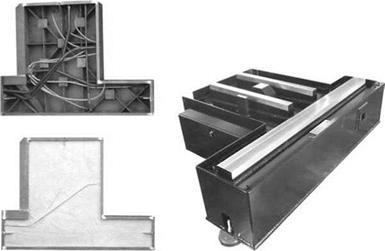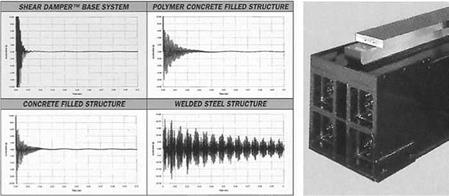Floor construction is a critical consideration when installing a new grinder. It must first and foremost be capable of supporting the weight without deforming. It should also absorb shock and isolate the machine from adjacent machine noise. The principles of vibration isolation of machines are described in detail by Den Hartog [1956]. For light machines, a sealed concrete floor 150 mm to
|
FIGURE 15.3 Construction steps in a polymer concrete-filled steel base weldment. (Courtesy of Weldon Solutions. With permission.) |
200 mm thick is usually sufficient in combination with elastic pads on the machine. Larger grinders will require an independent thick cast slab that may have to be isolated from the factory floor by shock-isolation elements. Because these slabs are made of concrete, which are slow to react to changes in temperature and, therefore, liable to warping, good temperature control of the factory is recommended. Many grinder bases, such as the one in Figure 15.3, are designed with 3-point floor support that allows, assuming the base has sufficient stiffness, for leveling of the grinder on uneven floors. However, with care of installation, a 5-point mount is actually more desirable in eliminating vibration modes especially from rocking or reversal of machine axes on machines such as reciprocating surface grinders [Yoshida 2000].
A machine table that reciprocates creates substantial inertia forces during the reversal of motion. A reciprocating surface grinder, unless anchored to the foundation, tends to “walk” across the floor.
|
|
This can be avoided by using anchor bolts sunk into the foundation. Provision must be included for leveling the machine on the foundations and also for vibration damping.


